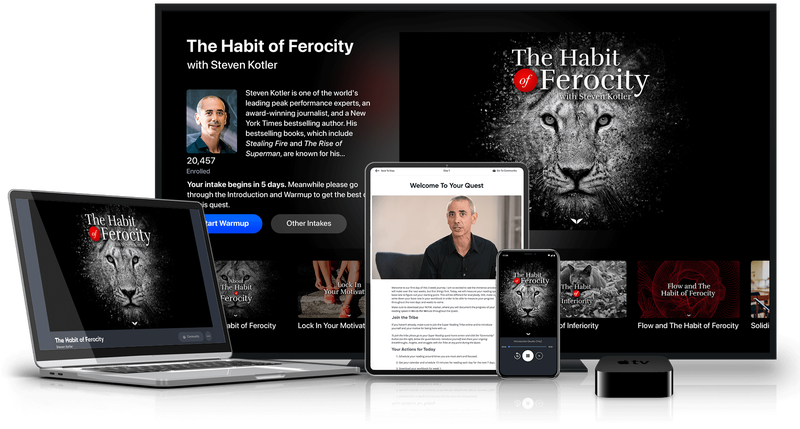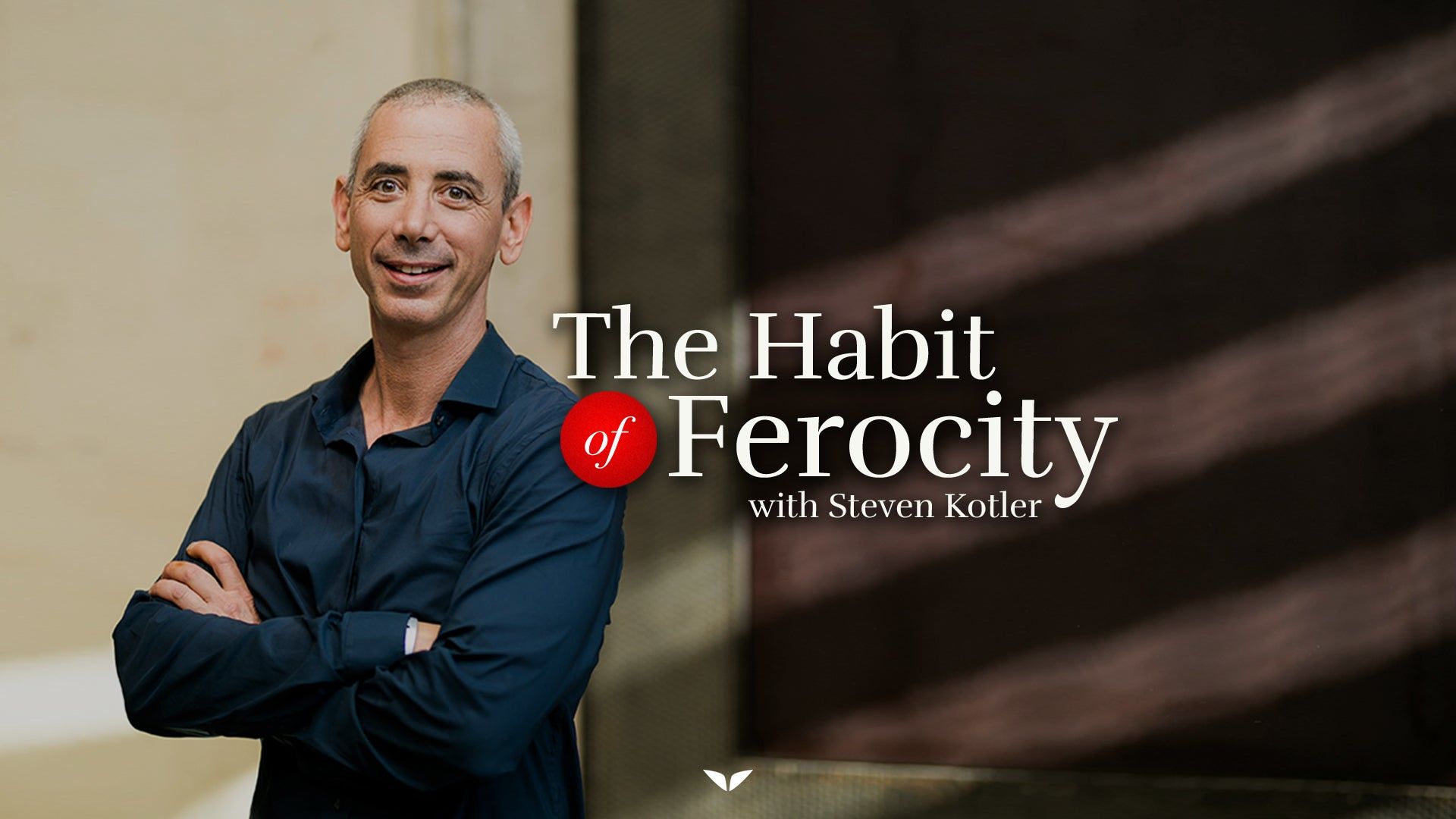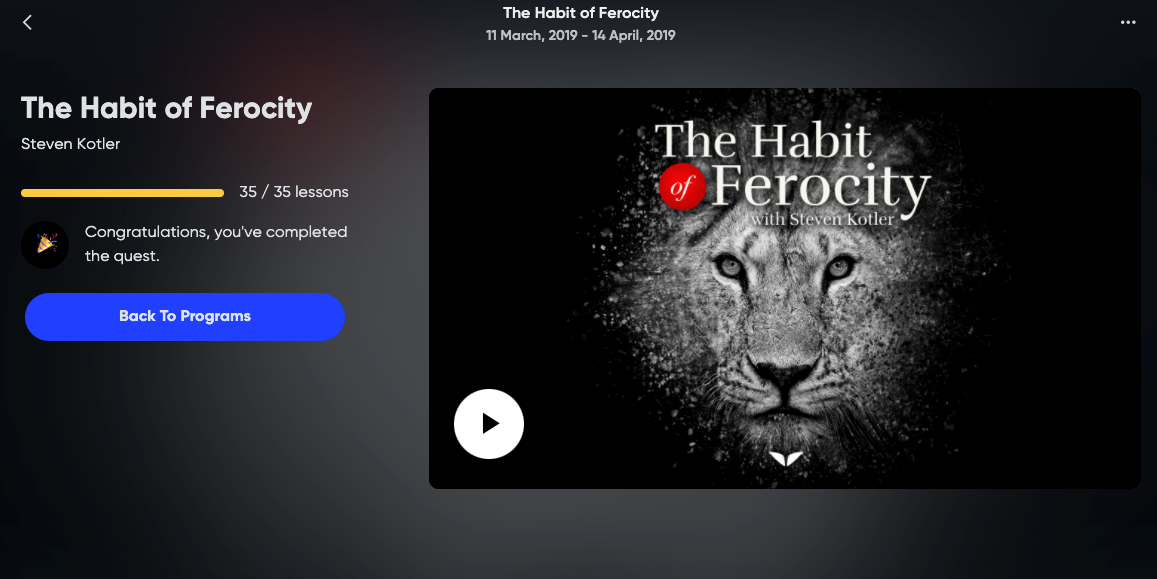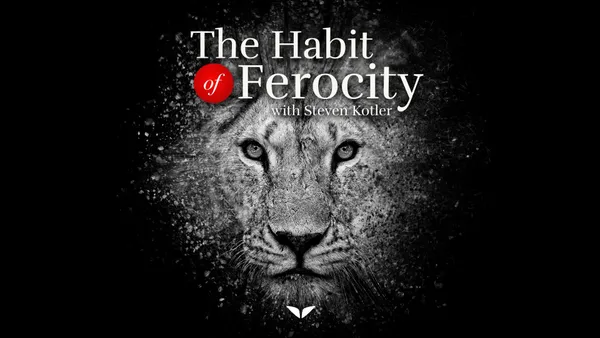
About The Course
The “Habit of Ferocity” course by Steven Kotler on the Mindvalley platform is 5 hours long and consists of 35 Lessons. Over 143885 people have enrolled as of October 16, 2021.
These lessons are spread over 15-20 minutes each over five weeks period. The course has allowed two days after each week for integration and introspection.
Who is Steven Kotler?
For those of us who don’t know who Steven Kotler is, here is a quick introduction.

Steven Kotler is one of the world’s leading peak performance experts, an award-winning journalist, and a New York Times bestselling author. His bestselling books, including Stealing Fire and The Rise of Superman
What I enjoyed about the course
- The energy with which Steven Kotler talks, I can feel his energy and enthusiasm; it was almost the most exciting and captivating course.
- I enjoyed how everything was brought together as the convergence of Neuroscience, Psychology, and Physiology. You can imagine how much research and hard work must have gone into compiling the whole course into easy-to-understand videos.
- High Production Quality of Videos.
- He introduced powerful and thought-provoking concepts such as: stacking all motivators (Curiosity, Passion, Purpose & Fear) to get the complete focus and flow. The connection between Curiosity and Passion. The connection between Passion & Purpose.
- Just being passionate is selfish. Our moral obligation is to try and seek ways to identify and turn those passions into Massively Transformative Purpose (MTP).
- Massively Transformative Fear (MTF)
- De-risking - Getting the right amount of fear in the equation. Not more, not less. Just enough to help us get in the flow.
- This program gives us a blueprint template to discover our purpose, surf that wave, and find the flow.
Things to take note of:
- While concepts are insightful, new, and thought-provoking, we will have to do most of the work. It requires a lot of introspection. We won’t find all the answers during introspection, but the course will make us look for them.
- Please don’t be impatient: Identifying our Massively Transformative Purpose and Massively Transformative Fear won’t be easy.
- Take the printouts of all the companion PDF handbooks. Write our insights, our thoughts, our insights, and our questions. They are going to be super helpful in processing our thoughts. We will often find ourselves coming back to them over and over again.
Course Structure
Part 1: Your Ferocity Primar
Your journey begins by laying the groundwork for your new high-performing self. Here Steven will show you how to prime your mind for the profound transformations to come. Plus, you’ll take a deep dive into the flow state and how it applies to the habit of Ferocity.
Part 2: Automating Motivation
Unbreakable motivation is one of the critical pillars of Ferocity. When staying motivated is no longer a willpower struggle, you’ll find yourself getting more done, doing better work, and perpetually looking forward to the next challenge and opportunity.
Highlights include:
- The neurobiology of turning curiosity into a passion: use this 5-step mind hack to get crystal-clear clarity on what you’re passionate about (and it’s not always what you think).
- How to be an ‘Expert’: discover why expertise is less about talent and intelligence and what you should be focusing on to be one of the best in your field.
- The surprising power of social reinforcement: how connecting with others can modify your biology and 10x your motivation.
- Turn passion into purpose: the definitive formula for elevating your passions into your big and audacious purpose (and multiplying your motivation in the process).
Part 3: Automation Flow
Flow is a state of peak consciousness that greatly amplifies your focus, productivity, and mastery of any given skill - and it’s also the subject Steven is most known for. Here you’ll learn how to master the flow state and harness it as a component of Ferocity.
Highlights include:
- Automating your peak performance: discover the simple daily habit that puts you in flow far more often, without even having to think about it.
- The neuroscience of goal achievement: Steven’s optimized approach to goal setting is unlike anything you’ve ever seen - and it’s the last one you’ll ever need.
- Goals that break flow vs. goals that encourage flow: knowing this simple difference could save you from years of failure and wasted energy.
Part 4: Automating Grit
No grit, no pearl. In a matter of days, Steven will retrain your neurology and physiology to roll with the punches and become unstoppable even in the face of extreme adversity. You’ll be surprised by what you’re able to achieve once you’ve automated Grit.
Highlights include:
- Most people think of the six types of Grit as perseverance, but there are many more. Here’s what they are and how to train and automate them.
- How to turn fear into your motivational compass: once you adopt this thought pattern, you’ll start welcoming significant challenges as an opportunity for growth instead of avoiding them.
- Strengthening your growth mindset: learn how to fortify your Grit by focusing on the rewards of growth instead of the pain of failure.
Part 5: A lifetime of Ferocity
Tie everything together in this wrap-up chapter that will turn Ferocity into an effortless habit from here on out.
Course Summary
For Future Reference
- We never rise to the challenge; we fall to our level of training. The whole idea of “Habit of Ferocity” is to train ourselves to automatically and instinctively rise to any challenge.
- The “Habit of Ferocity” is about stacking up and use all motivators to sustain peak performance, automating Grit and risk-taking, and harnessing flow.
- The three characteristics we need to achieve the impossible:4. The Size of Our Vision5. The Habit of Ferocity6. The Amount of Flow
- In facing challenges, fear shrinks our possible options into Fight, Flight, and Freeze.
- The Habit of Ferocity increases flow.
- Flow can have a radical impact on performance.
- Passion is a profound focusing mechanism and a flow trigger.
- By following our curiosity, we start Nurturing our passion.
- By training up our curiosity, we are training down fear.
- One curiosity is not enough to create true passions. Look for the intersection of multiple curiosities. Identifying these intersections releases dopamine, which is the ultimate focusing chemical. The incubation phase lets us develop expertise by giving our adaptive unconscious a chance to process new information continuously.
- A vast majority of a subject is hidden in the language. We have a storytelling brain. Learning the history of a topic provides an extensive picture framework for understanding the topic.
- Keep on exploring and play at the intersections until we start coming up with our ideas.
- By taking things public, we’re stacking motivations, igniting passion, and amping up learning.
- The purpose is a triple threat motivator:
- It moves the “I” to the “We.”
- It works as a focusing mechanism.
- Long term goal is to make a living off our purpose.
- MTP is like a mission statement, but more than that. It is enormous and aspirational, clearly focused, unique to us a person, aimed at radical transformation, and forward-looking.
- Massively Transformative Purpose (MTP) is difficult to achieve all by ourselves;
- Passion is selfish; the purpose is selfless. Purpose has to be bigger than us. It is essential to turn our passion into purpose so that other people can relate to and work towards achieving the common MTP.
- MTPs give us and others a reason to get out of bed in the morning.
- There are three core intrinsic motivators:
- Autonomy - Desire to steer our ship.
- Mastery - Desire to steer our ship well.
- Purpose - Desire for our journey to matter.
- The goal is to gain control of 15% of our time to pursue mastery.
- To get into the flow channel, we need challenges that are 4 % higher than our skill set. Goals should be challenging and just right outside our comfort zone. Live on the edge of your comfort zone. Find the sweet spot.
- Manage your energy levels. Work when you’re most energetic and focused.
- Experiment at different times in the day.
- Block 90 min slots in the calendar for deep work twice, once in the morning and evening.
- Having clear high, challenging goals can increase motivation by 11-25%.
- Neurobiological, high, challenging goals can heighten attention and amp up persistence.
- The three modifiers of high, challenging goals:
- High, Hard Goals (HHG) should be aligned with our values.
- Note to self: Identify Values. See the actions item below.
- High-Hard Goals should be challenging but attainable.
- Keep our goals to ourselves.
- It’s essential to know how many things we can do in a day while we are still at our best—the secret of clear goals: Gaining a lot of little wins.
- MTP -> HHG -> Sub-Goals -> Clear Goals -> Daily To Do List -> Follow GTD -> Next Action should be clear. Clarity is a flow trigger.
- Plan to carry out one high, 3 Medium, and 5 Low priority tasks every day. Stack little victories over victories—day after day. Our brain releases dopamine when we make progress every day in anticipation of the goal.
- Reduce gaps during deep work.
- Carry out state change protocol for regulating attention and changing
- gears such as shower, ten push-ups before the meetings, and spend 10 min on breathing exercises and meditation—box breathing for focus. Use the stoic app.
- Journal at the end of the day. Reflect on how well did you stick to your plan.
- Do Daily, Weekly, and Monthly Review. Keep Aligning your day-to-day tasks to your medium and long-term goals.
- There are two precursors to Grit:
- Mindset
- Willpower
- A growth mindset believes that talent is only a starting point. Results are up to us.
- Willpower is the ability to resist temptation, to delay gratification.
- Willpower is a limited resource; it depletes over time.
- To reset willpower, we need a state change.
- Grit itself is a habit. Therefore we can train it up and automatize it.
- The most accessible place to start training grit is on the physical level.
- Push a little bit (4%) more each time.
- Our brain tends to process more negative than positive thoughts.
- Practising a gratitude list will training our brain to start looking for more positive information.
- Get into the gap, and exaggerate the gap between thought and emotion using mindfulness practice.
- There’s only one way to be our best when we’re at our worst. It is to train when our at our worst.
- It is crucial to identify our potent weaknesses and train them up.
- We can overcome these by asking the opinion of our closest people.
- Fear is a constant companion.
- Top performers use fear as a compass.
- Before facing our fears, we need to learn how to de-risk or protect the downside.
- One way to de-risk is to assess the probabilities and increase our chance of success.
- Peak performers must practice Grit to recover.
- How to practice this Grit?
- Get enough night sleep. Go to bed same time, Wake up at the same time. Make it a habit. Do it day after day, every day.
- Focus on making an active recovery protocol, not just passive recovery: practice Yoga, Meditation, cold shower, workout, and massage.
- Do total reset sessions.
- Our life is defined by what we say YES to and what we say NO to.
- The core key to peak performance: keep our work and tell the truth to ourselves.
- So much success in life is what we automate.
- Developing the habit of Ferocity is a lifelong journey.
Conclusion

Next Action Items
- Spend more time on identifying your strengths and weaknesses with surgical precision.
- Use the Big 5 Personality Trait test to discover your personality with Dr Jordan B Perterson to help identify your strengths and weaknesses.
- Train your weaknesses once a week. Be ferocious. Understand your strengths, and use them well to achieve and pursue your Massively Transformative Purpose.
- Use SelfAuthoring.com Suite to help carve out your Massively Transformative Purpose and Massively Transformative Fears.
- Read the book Atomic Habits by James Clear
- Live an intentional life, not an accidental one.





